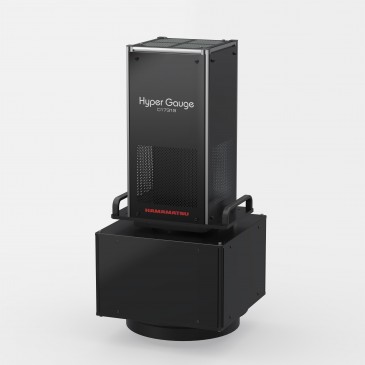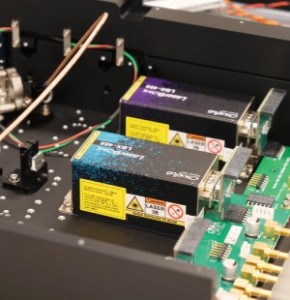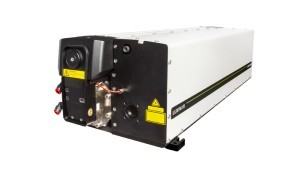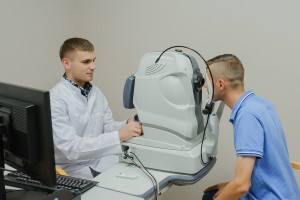
The global optical coherence tomography market size was valued at USD 1,474.1 million in 2021 and is projected to expand at a compound annual growth rate (CAGR) of 15.41% from 2022 to 2030. Constant innovation and development of newer technologies, higher demand for new biomedical applications such as drug delivery, rising demand for early diagnosis of the disease, and rising prevalence of eye disorders are expected to drive the OCT market growth. However, a lack of favorable reimbursement policies and clinical information can hamper the market growth in the coming years.
Optical coherence tomography (OCT) is an evolving technology used for high resolution cross sectional imaging. Optical coherence tomography (OCT) uses light for the cross sectional imaging of the tissue structure on the micron scale in situ and in real-time. OCT is a non-invasive imaging technique, which is used to perform an optical biopsy. It is used in the areas where traditional imaging techniques cannot be used. OCT is based on fiber optics and can be integrated with the instruments such as endoscopes, catheters, surgical probes, and laparoscopes, which enables imaging of the body. Furthermore, OCT is a portable and compact device, hence expected to drive the market in near future.
COVID-19 pandemic has led to a huge surge in demand for medical supplies and respiratory support devices such as life-support machines, atomizers, oxygen generators, and monitors. OCT angiography is used for the imaging of retinal vascular changes in fully recovered Covid-19 patients. The key manufacturers of OCT systems are struggling to maintain their production capacity, along with finding newer methods to strengthen their presence, such as mergers and acquisitions, and collaborations with suitable market players. These initiatives by market players can be positive for the market in the upcoming year.
The increasing prevalence of eye diseases is projected to fuel the global optical coherence tomography market in the forecast period. According to World Health Organization (WHO), almost 2.3 billion people are suffering from vision loss in 2019 due to unaddressed medical conditions such as cataracts, refractive errors, corneal opacities, glaucoma, trachoma, and diabetic retinopathy.
Optical coherence tomography is useful in the diagnosis of some major health disorders such as cardiovascular diseases, non-melanoma skin cancer, prostate cancer, and age-rated macular disease, to name a few. This requires the need for non-invasive and in vivo imaging technology to monitor and diagnose the disease and its overlying condition. Continuous development of the newer technologies and strong demand for OCT imaging from the developing countries are expected to drive the optical coherence tomography market.
Technology Insights
The frequency domain optical coherence tomography (FD-OCT) segment accounted for the largest revenue share of 37.2% in 2021. Frequency domain OCT systems are mainly based on the measurement of the interference spectrum hence also called spectral-domain OCT (SD-OCT). The Spectral Domain OCT uses interferometric signals as an aid for imaging which helps by increasing the imaging speed up to 50 times. Thus providing a greater number of images per unit area and boosting the market penetration during the forecast years.
Time domain optical coherence tomography (TD-OCT) is expected to expand at the highest CAGR of 15.94% during the forecast period. Time domain OCT is the traditional technique applied for the examination of the retinal screen of the eye. TD-OCT is used to examine the retinal thickness by measuring the distance between the internal limiting membrane and the highest hyper-reflective band. It is used in the diagnosis of several retinal conditions, such as macular hole, macular pucker, vitreomacular traction, and macular edema.
Type Insights
Handheld OCT devices held the largest share of 46.3% in 2021. Handheld OCTs are a combination of microelectromechanical systems (MEMS) with 3D imaging to help in the early detection of multiple eye disorders. This helps in the detection of diabetic retinopathy, macular degeneration, and glaucoma.
Doppler OCT devices are expected to expand at the highest CAGR of 16.88% during the forecast period owing to wide use in the areas of ophthalmology, dermatology, gastrointestinal endoscopy, and cardiology, and ability to image dynamic flow parameters such as pulsatility and reduced time of processing.
The tabletop OCT devices are the traditional type of non-invasive devices used to scan the retina to check for any kind of eye disorders on the occurrence of certain symptoms. Tabletop OCTs require proper infrastructure and are non-portable.
Application Insights
Ophthalmology held the largest share of 59.6% in 2021. Ophthalmology is projected to witness rapid growth in the future due to the increasing incidences of choroidal and retinal disorders, which, in turn, leads to the increasing adoption of optical coherence tomography devices by an ophthalmologist for imaging and diagnosing purposes. Furthermore, rising prevalence of cataracts and glaucoma, people will go forward with the early disease diagnosis and better treatment options with the OCT devices, which is expected to boost the market.
Key Companies & Market Share Insights
The market is fragmented with the high competition at the global level. Strategic partnerships with local distributors and region-based type variations are some of the initiatives adopted by global players. Major companies are investing in R&D for the new product development and product launch to serve the market demand. For instance, in 2020, Abbott announced the first optical coherence tomography virtual reality product used for training of the cardiologists. In 2019, TOPCON Canada Inc. announced the launch of 3D Maestro2, which is a spectral domain optical coherence tomography system with optional optical coherence tomography angiography. Some of the prominent players in the optical coherence tomography market include:
Afga Healthcare
Carl Zeiss Meditec AG
Heidelberg Engineering GmbH
Imalux Corporation
Michelson Diagnostics
Novacam Technologies Inc.
OPTOPOL Technology S.A.
Topcon Medical Systems
Thorlabs Inc.






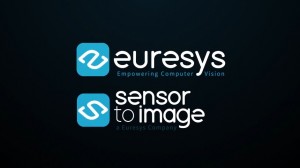





























 Back to News
Back to News